Draw a Free Body Diagram for the Parachutist
This brusk tutorial is near drawing a free trunk diagram of askydiver with parachute. The obtained results volition look similar the next illustration. Mainly, nosotros will learn how to:
- drawanarc in LaTeXusingTikZ,
- use foreach loopforrepetitive objects,
- draw animals in TikZ using thepackage TikZlings,
- draw arrows andmodify line width.
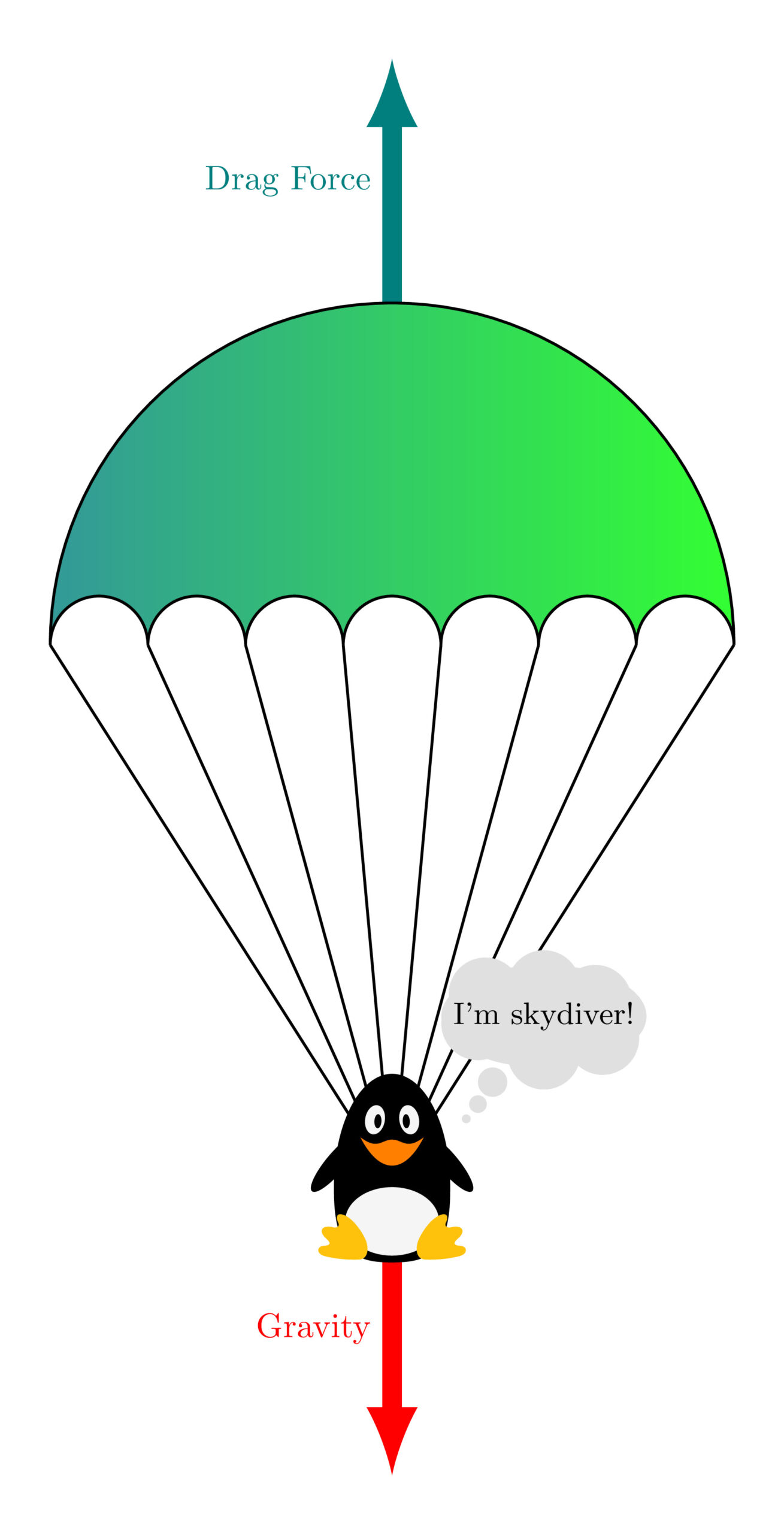
Step ane: Awning of the Parachute
Thecanopyis one of the principal components of a parachute system. In thistutorial, we volition depict the simplest version of information technology using but linked arcs such that the end point of an arc is the start bespeak of the side by side i. This is repeated until we reach the starting point of the get-go arc. Allow's offset by answering the questionhow to describe an arc in TikZ?
The post-obit LaTeX lawmaking corresponds to the canopy office which is drawn past the hateful of 7 arcs:
\documentclass[border=0.5cm]{standalone} \usepackage{tikz} \begin{document} \begin{tikzpicture} % Canopy \draw (0:iii.5) arc(0:180:3.5) arc (180:0:0.v) arc (180:0:0.5) arc (180:0:0.v) arc (180:0:0.5) arc (180:0:0.5) arc (180:0:0.5) arc (180:0:0.v)-- bicycle; \end{tikzpicture} \finish{document} Starting from the signal (3.5,0), we draw an arc from 0 degree to 180 degrees with radius three.5cm. Then, another smaller arc with radius 0.5cm is drawn from the terminate point of the previous arc. It starts from 180 degrees to 0 degrees.
The same procedure is repeated for the remaining 6 arcs!
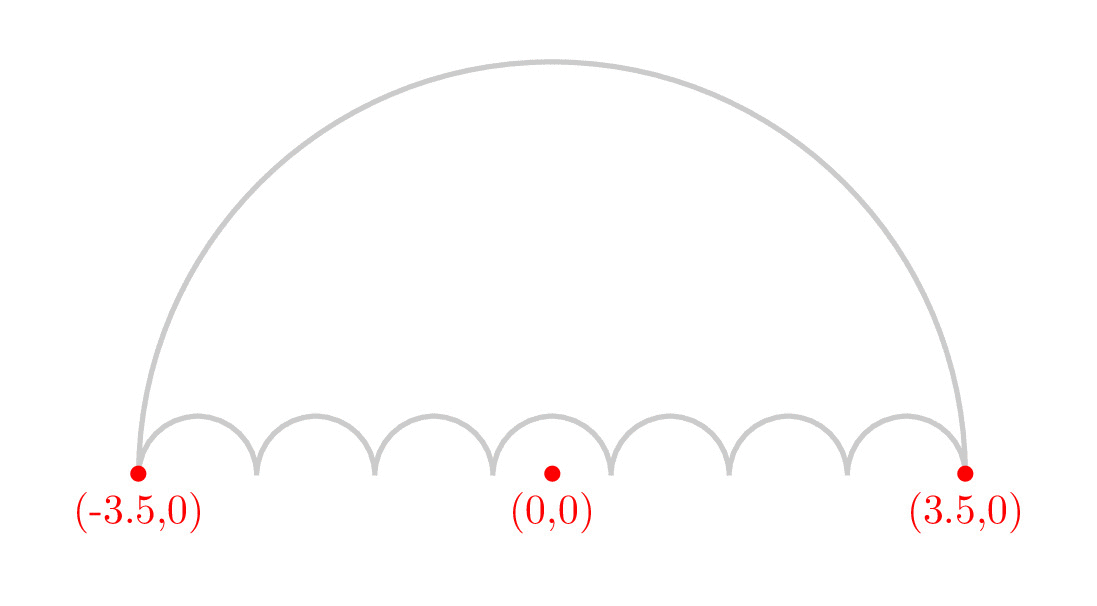
Simplify the code with a For Loop
The above code tin exist optimized by using a for loop which can be achieved through the foreach control. Here is the obtained result:
\documentclass[border=0.5cm]{standalone} \usepackage{tikz} \begin{document} \begin{tikzpicture} % Canopy \describe [left color=teal!80, right colour=green!80](0:3.5) arc(0:180:three.5) \foreach \i in {one,...,7}{arc (180:0:0.5) }-- cycle; \end{tikzpicture} \end{document} Nosotros used a foreachto repeat the same command,arc(180:0:0.5)),7 times!
Furthermore, we have added shading to the canopy shape by specifying the fifty eft and right colors in thedraw control. For a detailed list ofpredefined TikZ colors, I invite yous to check this post: Predefined LaTeX Colors: dvipsnames
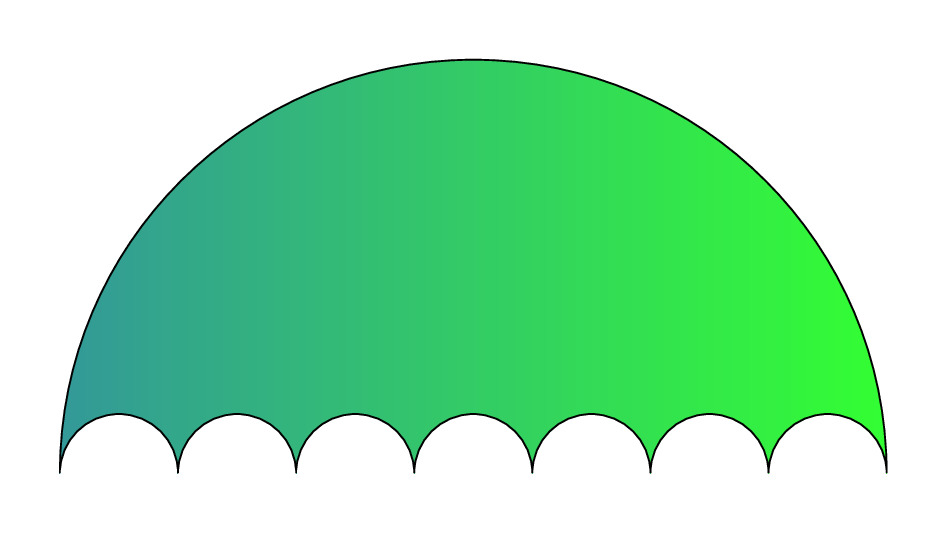
Stride ii: Suspension Lines
From the extremities of each arc, nosotros will depict a straight line that ends at the point with coordinates (0,-five.v). Every bit it is a repetitive shape, nosotros will use a foreach command that specifies thex-coordinate of each starting betoken. Here is the LaTeX code:
\documentclass[edge=0.5cm]{standalone} \usepackage{tikz} \begin{document} \brainstorm{tikzpicture} % Canopy \draw [left colour=teal!80,right color=green!80](0:iii.five) arc(0:180:3.5) \foreach \i in {1,...,seven}{arc (180:0:0.5) }-- bike; % Pause lines \foreach \i in {-three.5,...,3.v} { \draw (\i,0) -- (0,-5.five); } \end{tikzpicture} \stop{document} 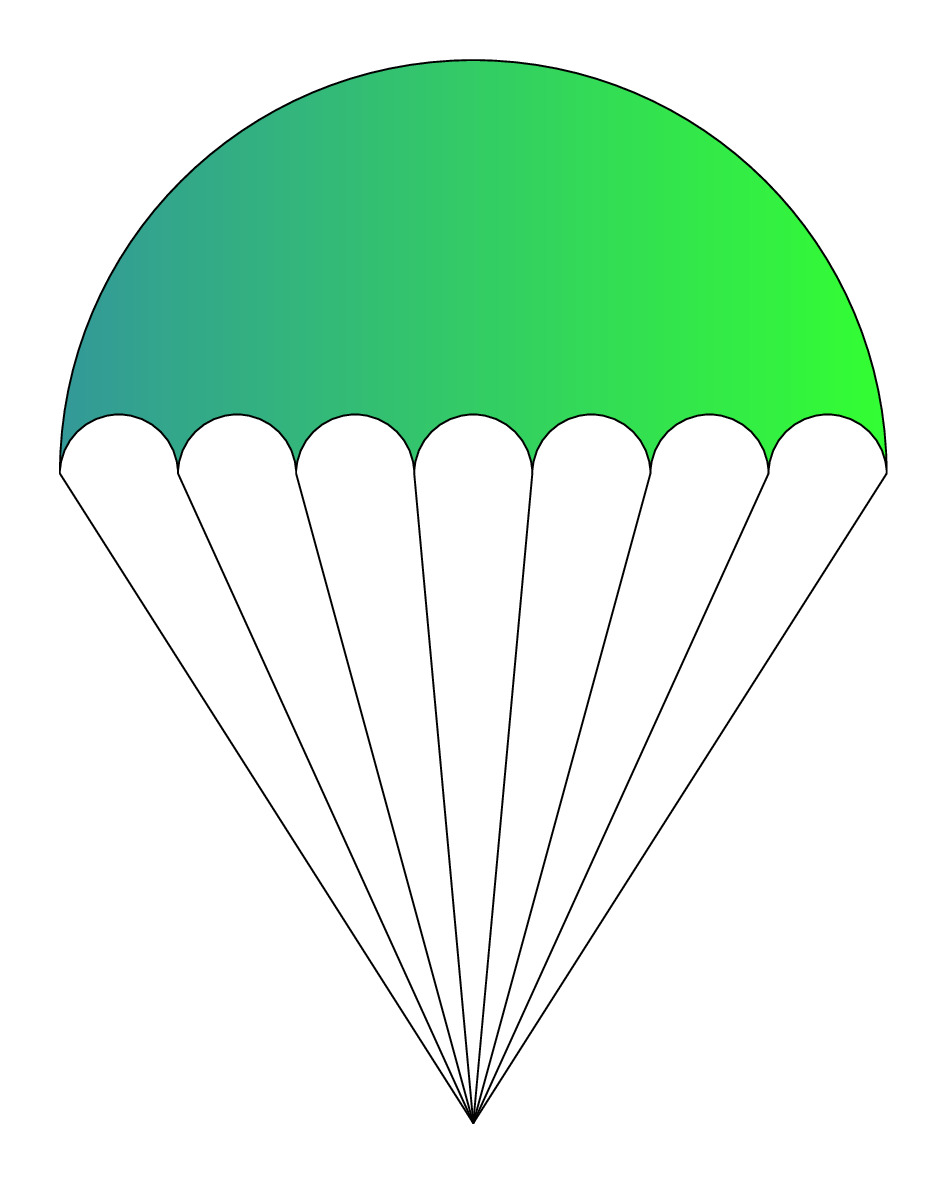
Now, it remains to draw the essential part of the analogy, The Skydiver 
Step 3: TikZ animals
Tikzlings package ,developed by samcarter, offers a collection of animals and beings drawn in TikZ. It includes:
- carry
- true cat
- coati
- hippo
- koala
- marmot
- moles
- mouse
- owl
- panda
- penguin
- pig
- rhinoceros
- sloth
- anteater
- squirrel
- bee
- and the snowman
The next analogy shows the animals list with the corresponding commands.
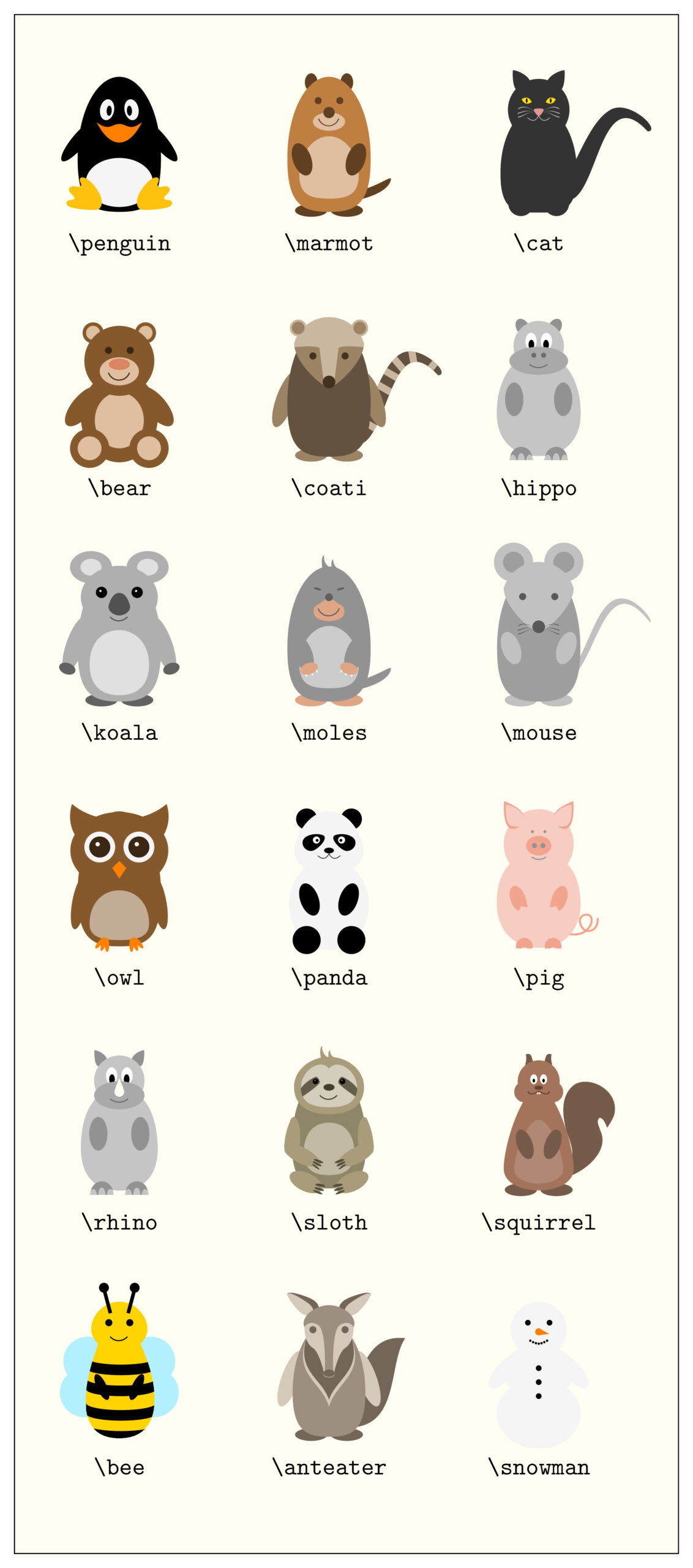
This amazing package as well includes different options such as: irresolute colors, draw a back version of the animal, describe a 3D version, add together accessories and much more!
Describe the Skydiver
The penguin volition play the role of a skydiver. To depict it we need to load theTikzlings package or merely the subpackage containing the animate being tikzlings-penguins . So we use the command \penguin within a scope to put it at any desired position as information technology is drawn at the origin by default.
\documentclass[border=0.5cm]{standalone} \usepackage{tikz} \usepackage{tikzlings-penguins} \brainstorm{document} \begin{tikzpicture} % Canopy \describe[left color=teal!80,right colour=green!fourscore](0:3.five) arc(0:180:3.five) \foreach \i in {1,...,seven}{arc (180:0:0.v) }-- cycle; % Pause lines \foreach \i in {-3.5,...,three.five} { \describe (\i,0) -- (0,-5.5); } % Skydiver (Penguin) \begin{scope}[yshift=-6.5cm] \penguin \thing[ retrieve={\minor I'thou skydiver!}, scale=1.v, yshift =-0.6cm, xshift=-0.05cm] \finish{telescopic} \end{tikzpicture} \end{document} We have added athinking shape using the command katex is not defined withscalingandshifting options to put information technology at the correct position. I deeply invite you to check the amazing accessories and customization that you tin can add together in the bundle documentation.
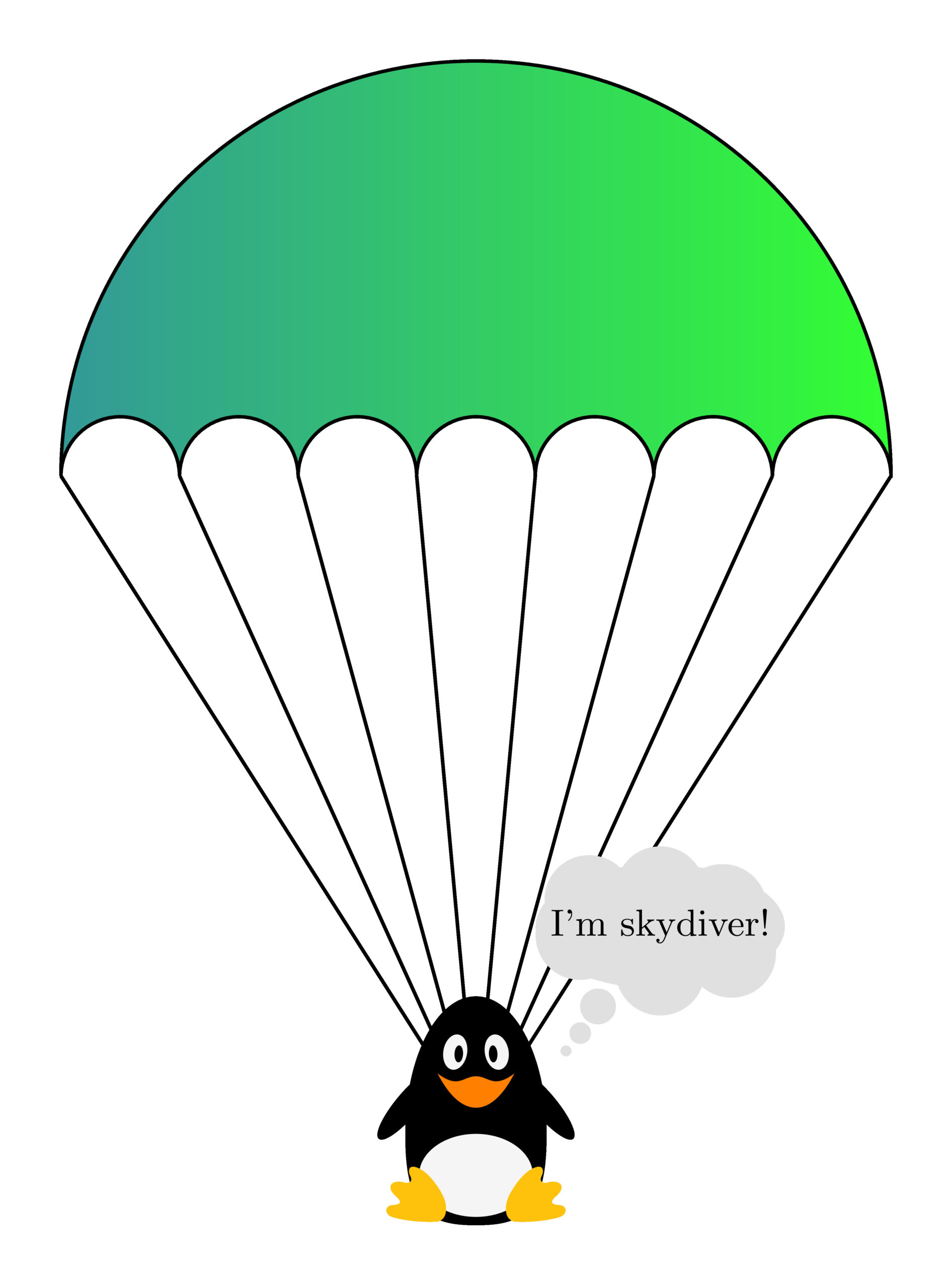

Costless Body Diagram of a Skydiving-Parachute system
Step iv: Free Body Diagram
Now, nosotros demand to draw arrows that represent different forces applied on the skydiving-parachute system, namely, the gravity and the air resistance force. Here is the final LaTeX code of thecostless body diagramof this organization:
\documentclass[edge=0.5cm]{standalone} \usepackage{tikz} \usepackage{tikzlings-penguins} \begin{document} \brainstorm{tikzpicture} % Free body diagram % Gravity \describe[-latex, line width=0.2cm,crimson] (0,-v.5) -- ++(0,-3cm) node[midway,left]{Gravity}; % Air resistance force \draw[-latex, line width=0.2cm,teal] (0,three.v) -- ++(0,2.5cm) node[midway,left]{Drag Force}; % Canopy \draw[left color=teal!80,right color=light-green!80](0:3.5) arc(0:180:3.5) \foreach \i in {1,...,7}{arc (180:0:0.5) }-- bike; % Suspension lines \foreach \i in {-three.five,...,3.5} { \depict (\i,0) -- (0,-5.5); } % Skydiver (Penguin) \begin{scope}[yshift=-6.5cm] \penguin \thing[ think={\small I'm skydiver!}, scale=i.five, yshift =-0.6cm, xshift=-0.05cm, ] \end{telescopic} \finish{tikzpicture} \end{document} Comments:
Arrows are drawn by adding the selection -latex to \draw command. The thickness of the arrow is changed by modifying the line width value as follows: line width=0.2cm .
We have arrived to the end of the tutorial, I hope yous discover it useful 


Thanks!
Source: https://latexdraw.com/tikz-free-body-diagram-skydiver-with-parachute/